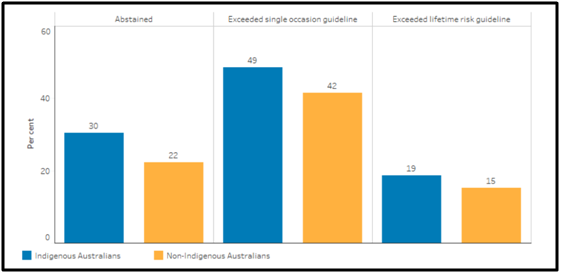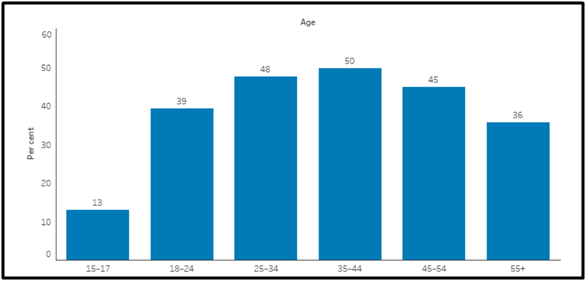(NRSG371) Nursing assignment on building health communities of FIFO workers with reference to Australian Health Performance Framework
Question
Task: Can you write a nursing assignment on building health communities of FIFO workers with reference to Australian Health Performance Framework?
Answer
Question 1 of the nursing assignment
Two modifiable health behaviours
The behaviours among the members of the FIFO community that are modifiable are stated as follows in the nursing assignment.
Alcohol consumption
A huge amount of alcohol consumption as per the nursing assignmentcan result in health and social problems, according to the latest report of the National Health and Medical Research Council (NHMRC). Excessive alcohol consumption for a long period of time can result in several health-related issues, including pancreatitis, diabetes, obesity and cancer (NHMRC, 2020). Drinking habit in the members of the FIFO community is identified as 'binge drinking' that may lead to injuries and death as a result of accidents, violence, and suicidal actions. According to a conducted survey mentioned in the nursing assignment, alcohol consumption has contributed to 20% of the road accident injuries involving vehicles in 2015 and 14% of the suicidal and self-initiated injuries (Roche et al., 2020).

Table 1: Alcohol consumption rates according to occasions in Australia.
(Indigenoushpf.gov.au, 2022).
For example, native Australians aged 18–24 are most likely to engage in a single occasion alcohol consumption risk (65%), and the age group 15-17 has the least rate (18%).
Smoking
According to the nursing assignment, it can be stated that about two-thirds of the deaths in Australia can be caused due to smoking at present. The present smokers are predicted to have 10 years more premature death than non-smokers. Around 18,800 Australians are affected with major chronic diseases as a result of smoking which enhances the financial risk to the community. Smoking is the leading factor that can be modified in the health behaviour sector. The smoking rate among Australian citizens is observed from 29% in big cities to 58% in remote village areas as per the data of nursing assignment. The native residents of Australia are recognised as heavy smokers compared to the others (Chapman et al., 2021).

Figure 1: Age versus year-wise comparative smoking rates in Australia.
(Indigenoushpf.gov.au, 2022).
The conducted survey in the nursing assignmentstates that in 2018 -19 the rate of smoking for the natives of Australia was lowest in the age group 15 to 17, which is around 13% and highest in the age group 35 to 44, which is around 50%.
For example, the accident rate has a direct link with the alcohol consumption rate.
Challenges that the nurses may experience
Nursing can be stated in the nursing assignmentas rewarding as well as challenging careers in general. While working with the transient FIFO community, the major challenges identified are as follows.
Emotional engagement
The job role conducted by nurses includes personal mental engagement with the patients. This may lead to emotional involvement in the patient and their lifestyle, which can affect their mental health. The support system cannot always be built in a strong and effective way to control emotions and feelings (Skinner & Roche, 2021).
Physical hard work
The hard work as per the nursing assignmentis the involvement of working in long shifts for about 10 to 12 hours a day. The shifts lasting for longer than the expected time leads to mental and physical taxing and energy deprivation. The nursing duty involves a number of physical activities like shifting, lifting and assisting patients for their comfort. Lifting and carrying heavy objects and standing for a long time may cause strain with the risk of back injury. The strength and stamina have to be high in order to be an expert in physical tasks (Lenthall et al., 2018).
Poor treatment from the members
While discussing the nature of the transient FIFA community in the nursing assignment, it has been observed that the workers are strugglers and stressed with their life. They are alcoholics and have the habit of smoking, which is related to behavioural changes. These changes include aggressive behaviour, which may lead to mental or physical abuse in an extreme scenario (Maharaj, Lees & Lal, 2019).
Question 2 of the nursing assignment
Describing how Jenelle can engage with the FIFO community in the nursing assignment
Janelle, the occupational health nurse who has been employed for health training among the FIFO employees, needs to be accountable to the community as per the nursing assignment. The process of engagement may take place with the help of stage 2 health-promoting planning cycle. The identified risk associated with the behaviours needs to be spread as awareness among the members. The identification of needs and the target groups with key issues is required for the development of the implementation and risk intervention followed by the evaluation process in a cyclic manner.
The consequences of the modifiable health habits mentioned in the nursing assignmentneed to be described along with the severity. Behavioural changes can be attained with proper communication followed by rules and regulations. The patient himself as to avoid office health conditions and possible deteriorations that may take place with the continuation of the identified risky behaviours. The well-being of the patients can be assured with the development and execution of the action plan designed based on the given scenario.
Action plan
SMART Goals
The SMART Goals for the action plan development in working with the FIFO employees.
|
Specific |
Measurable |
Attainable |
Relevance |
Time-Bound |
|
Improving food habits |
Providing a way of having adequate food. |
Making a canteen for adequate food supply. |
Enhances health conditions and reduces weight (Weatherall et al., 2020). |
7 days. |
|
Reduction of Alcohol consumption |
Reducing the rate of alcohol consumption of upto 40% of the workers. |
Setting individual goals for consumption checking (Booker et al., 2020). |
Preventing chronic diseases and weight gaining. |
15 days. |
|
Improving Sleep Cycle |
Follow a schedule. |
Provide and secure a specific schedule for the whole day. |
Reduce chances of diseases. |
1 month. |
Table 1: SMART Goals
Strategies of nursing assignment
The Strategies for the development and execution of the action plan are decided as follows:
Engagement of the members in mandatory physical activities like workouts and yoga along with medications for the specific diseases.
FIFO community members with two or more risks in the health behaviours need to be handled, especially with target goals for achievement as per the nursing assignment.
The working schedules of the workers can be altered so that they don't get the evenings to spend drinking and smoking.
Evaluation
The smoking habits of the FIFO employees are not identified in mass; however, alcohol consumption is identified among around 65% of the members working in the bauxite mine. Therefore, the schedule of evening visits to the local pub for most of the workers needs to be altered with immediate action. Weight gain and high blood glucose levels are identified as the result of excessive alcohol consumption and disrupted food habits. Therefore it can be stated in the nursing assignment, the preliminary focus is concentrated on the improvement of food habits and reduction of alcohol consumption. The update and follow-up on the developed action plan can help in the reduction of risky health behaviours which are identified in the workplace health screening process.
The role of the nurses and members of multidisciplinary teams during the preparation of an Action plan
The nurses and the multidisciplinary teams need to be involved in the development of an action plan for the enhancement of health conditions and modification of the possible health conditions. The preliminary stage mentioned in the nursing assignmentis the identification of risky health behaviours through a workplace health screen. The goal-setting process is extremely sensitive and an important part of the action plan for the goals to be reliable and effective for the patients. Therefore, the nurses and members of disciplinary teams need to study the situation and its severity before developing an action plan. On the other hand, the acceptance of the smart goals by the target patients needs to be confirmed while the plan is developed. Apart from the common goals mentioned in the nursing assignment, specific targets have to be given by studying the individual behaviour and risk associated. The members of disciplinary teams can focus on studying individual cases and develop reports along with the necessary individual goals to achieve better and more successful interpretations.
Reference List
Booker, L. A., Sletten, T. L., Alvaro, P. K., Barnes, M., Collins, A., Chai Coetzer, C. L., ... & Howard, M. E. (2020). Exploring the associations between shift work disorder, depression, anxiety and sick leave taken amongst nurses in the nursing assignment. Journal of Sleep Research, 29(3), e12872.Available At: https://doi.org/10.1111/jsr.12872 [Accessed on: 11-07-2022].
Chapman, J., Roche, A. M., Duraisingam, V., Phillips, B., Finnane, J., &Pidd, K. (2021). Working at heights: patterns and predictors of illicit drug use in construction workers. Drugs: Education, Prevention and Policy, 28(1), 67-75. Available At: https://doi.org/10.1080/09687637.2020.1743645 [Accessed on: 11-07-2022]
Indigenoushpf.gov.au (2022). 2.15 Tobacco use - AIHW Indigenous HPF. Available At:
https://www.indigenoushpf.gov.au/measures/2-15-tobacco-use [Accessed on: 11-07-2022]
Indigenoushpf.gov.au (2022). 2.16 Risky alcohol consumption - AIHW Indigenous HPF. Available At: https://www.indigenoushpf.gov.au/measures/2-16-risky-alcohol-consumption#references [Accessed on: 11-07-2022].
Lenthall, S., Wakerman, J., Dollard, M. F., Dunn, S., Knight, S., Opie, T., ... & MacLeod, M. (2018). Reducing occupational stress among registered nurses in very remote Australia: A participatory action research approach. Collegian, 25(2), 181-191. Available At:
https://doi.org/10.1016/j.colegn.2017.04.007 [Accessed on: 11-07-2022]
Maharaj, S., Lees, T., & Lal, S. (2019). Prevalence and risk factors of depression, anxiety, and stress in a cohort of Australian nurses. International Journal of Environmental Research and Public Health, 16(1), 61.Available At: https://doi.org/10.3390/ijerph16010061 [Accessed on: 11-07-2022]
NHMRC (2020). Australian Guidelines To Reduce Health Risks From Drinking Alcohol in nursing assignment. (ed., Department of Health). Department of Health: National Health and Medical Research Council Available At: https://www.nhmrc.gov.au/file/15923/downloadtoken=t0Hrxdvq [Accessed on: 11-07-2022].
Roche, A. M., Chapman, J., Duraisingam, V., Phillips, B., Finnane, J., &Pidd, K. (2020). Construction workers' alcohol use, knowledge, perceptions of risk and workplace norms. Drug and Alcohol Review, 39(7), 941-949. Available At: https://doi.org/10.1111/dar.13075 [Accessed on: 11-07-2022].
Skinner, N., & Roche, A. (2021). RESPECT: Psychosocial Factors Outdo Employment Conditions in Predicting Job Satisfaction and Turnover Intentions for AOD Nurses and Counsellors. International Journal of Mental Health and Addiction, 1-16. Available At:
https://doi.org/10.1007/s11469-021-00676-y [Accessed on: 11-07-2022]
Weatherall, T. J., Conigrave, K. M., Conigrave, J. H., & Lee, K. S. (2020). What is the prevalence of current alcohol dependence, and how is it measured for Indigenous people in Australia, New Zealand, Canada and the United States of America? A systematic review in nursing assignment. Addiction Science & Clinical Practice, 15(1), 1-11. Available At: 10.1186/s13722-020-00205-7 [Accessed on: 11-07-2022].












